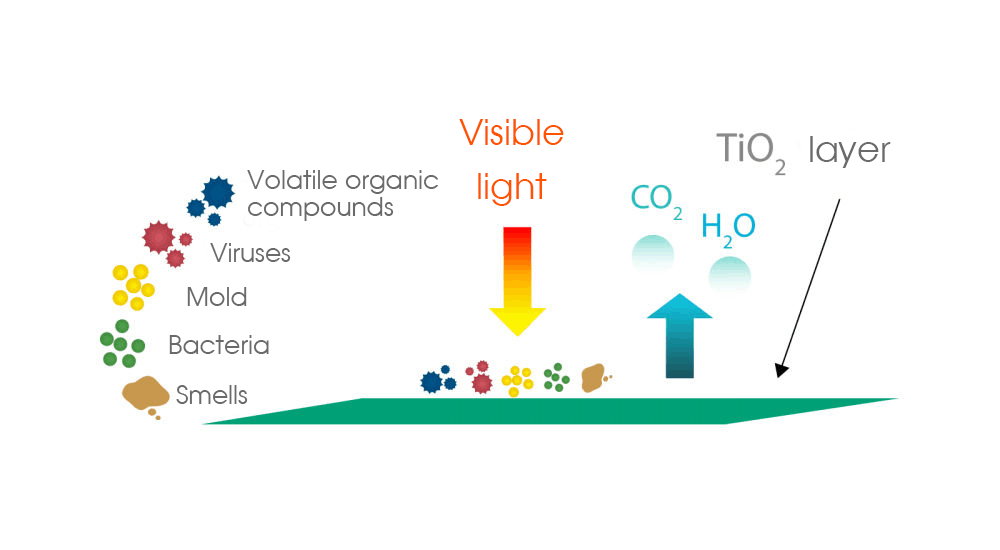
The NanoAirCleaner air purifier is based on a new technology called photocatalysis. Unlike regular air filters, this technology doesn’t trap impurities within the body of the device; it breaks down the impurities into basic non-toxic substances. Photocatalysis is based on a simple chemical reaction driven by light. The basic principles of photocatalysis have been known for more than a century.
The technology combines a non-toxic and highly effective photocatalyst in the form of a thin film and a UVA light source (this is the light used in night clubs and as a bug killer). This creates energy that destroys pollutants present in the air and transforms them into benign non-toxic substances such as water and carbon dioxide. Thanks to the nature of the photocatalyst that we use, this process can continue without the need to change filters or refill cartridges. Our product uses titanium dioxide applied to metal substrates.
The diagram shows that the reaction is based on generating a free electron, upon irradiating the particle with sufficient UV light. This was first described by Albert Einstein in his works on the photoelectric effect, which earned him the Nobel Prize in 1921. The photoelectric effect forms the basis of many modern technologies including solar energy, space exploration and night vision. Photocatalysis is another field utilising this phenomenon. Modern photocatalysis was established in Japan with the work of Fujishima and Honda, as described in 1971.
Until recently the widespread use of photocatalysis was constrained by difficulties in finding the correct procedure of embedding the photocatalyst onto the substrate so that a sturdy and robust layer is formed. Thanks to advanced knowledge in nanotechnologies in the Czech Republic, the procedure of creating a cutting-edge photocatalytic coating was achieved after just 2 years of development. The essential know-how lies in creating various thicknesses of the active layers on metal panels at specific temperature ranges.


NanoAirCleaner uses small fans (up to 10 W) to drive the air through the device. First a simple washable mesh filter is used to remove large particles (over 100 micrometres). Next the air is directed onto a set of aluminium-based panels coated with the photocatalyst. These panels are irradiated with UVA light, which commences the photocatalytic action. Our ingenious design allows between 2 and 4 square metres of active surface to be utilised in the purification process. This guarantees a high effectiveness of air cleaning. The photocatalyst is not consumed or transformed in the reaction, in which the final products are non-toxic substances such as water and carbon oxide.
In short, smart use of photocatalysis allows air purification where only light is needed, there are no filters to be replaced and there is a highly efficient rate of cleaning. Photocatalysis brings the following advantages.
It is necessary to emphasise that light sources other than UVA are unsuitable for use in household air purifiers. Germicidal UVC light may be effective, but it is extremely dangerous and even the shortest exposure to human eyes can lead to permanent blindness. Also, UVC produces toxic ozone.